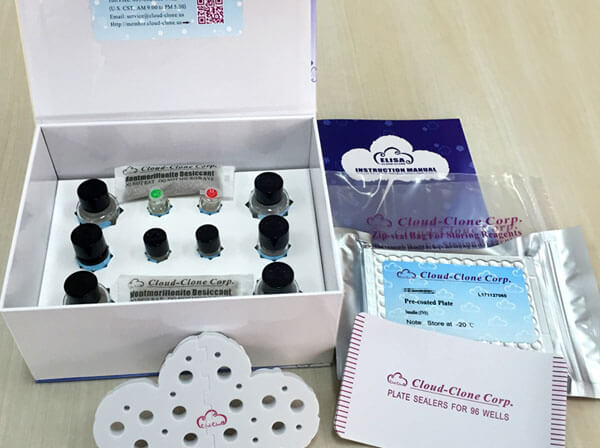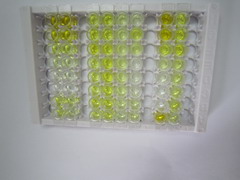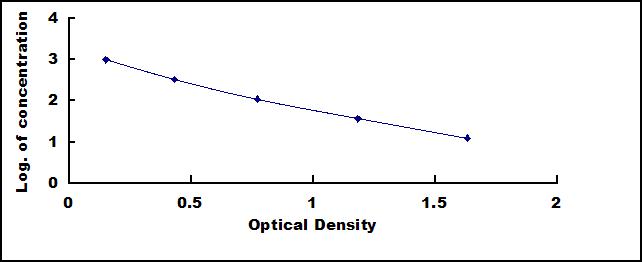ELISA Kit for Sphingosine-1-Phosphate (S1P) 

- UOM
- FOB US$ 658.00 US$ 940.00 US$ 4,230.00 US$ 7,990.00 US$ 65,800.00
- Quantity
Overview
Properties
- Product No.CEG031Ge
- Organism SpeciesPan-species (General) Same name, Different species.
- ApplicationsEnzyme-linked immunosorbent assay for Antigen Detection.
Research use only - DownloadInstruction Manual
- Category
Sign into your account
Share a new citation as an author
Upload your experimental result
Review

Contact us
Please fill in the blank.
Recovery
Matrices listed below were spiked with certain level of Sphingosine-1-Phosphate (S1P) and the recovery rates were calculated by comparing the measured value to the expected amount of Sphingosine-1-Phosphate (S1P) in samples.
| Matrix | Recovery range (%) | Average(%) |
| serum(n=5) | 94-105 | 98 |
| EDTA plasma(n=5) | 81-98 | 86 |
| heparin plasma(n=5) | 80-103 | 82 |
Precision
Intra-assay Precision (Precision within an assay): 3 samples with low, middle and high level Sphingosine-1-Phosphate (S1P) were tested 20 times on one plate, respectively.
Inter-assay Precision (Precision between assays): 3 samples with low, middle and high level Sphingosine-1-Phosphate (S1P) were tested on 3 different plates, 8 replicates in each plate.
CV(%) = SD/meanX100
Intra-Assay: CV<10%
Inter-Assay: CV<12%
Linearity
The linearity of the kit was assayed by testing samples spiked with appropriate concentration of Sphingosine-1-Phosphate (S1P) and their serial dilutions. The results were demonstrated by the percentage of calculated concentration to the expected.
| Sample | 1:2 | 1:4 | 1:8 | 1:16 |
| serum(n=5) | 89-101% | 94-103% | 82-99% | 82-104% |
| EDTA plasma(n=5) | 81-94% | 90-98% | 78-96% | 84-97% |
| heparin plasma(n=5) | 98-105% | 78-105% | 86-95% | 78-96% |
Stability
The stability of kit is determined by the loss rate of activity. The loss rate of this kit is less than 5% within the expiration date under appropriate storage condition.
To minimize extra influence on the performance, operation procedures and lab conditions, especially room temperature, air humidity, incubator temperature should be strictly controlled. It is also strongly suggested that the whole assay is performed by the same operator from the beginning to the end.
Reagents and materials provided
| Reagents | Quantity | Reagents | Quantity |
| Pre-coated, ready to use 96-well strip plate | 1 | Plate sealer for 96 wells | 4 |
| Standard | 2 | Standard Diluent | 1×20mL |
| Detection Reagent A | 1×120µL | Assay Diluent A | 1×12mL |
| Detection Reagent B | 1×120µL | Assay Diluent B | 1×12mL |
| TMB Substrate | 1×9mL | Stop Solution | 1×6mL |
| Wash Buffer (30 × concentrate) | 1×20mL | Instruction manual | 1 |
Assay procedure summary
1. Prepare all reagents, samples and standards;
2. Add 50µL standard or sample to each well.
And then add 50µL prepared Detection Reagent A immediately.
Shake and mix. Incubate 1 hour at 37°C;
3. Aspirate and wash 3 times;
4. Add 100µL prepared Detection Reagent B. Incubate 30 minutes at 37°C;
5. Aspirate and wash 5 times;
6. Add 90µL Substrate Solution. Incubate 10-20 minutes at 37°C;
7. Add 50µL Stop Solution. Read at 450 nm immediately.

Test principle
This assay employs the competitive inhibition enzyme immunoassay technique. An antibody specific to S1P has been pre-coated onto a microplate. A competitive inhibition reaction is launched between biotin labeled S1P analogues and unlabeled antigen (Standards or samples) with the pre-coated antibody. After incubation the unbound conjugate is washed off. Next, avidin conjugated to Horseradish Peroxidase (HRP) is added to each microplate well and incubated. The amount of bound HRP conjugate is reverse proportional to the concentration of S1P in the sample. After addition of the substrate solution, the intensity of color developed is reverse proportional to the concentration of S1P in the sample.
Giveaways
Increment services
Citations
- Quercetin ameliorates pulmonary fibrosis by inhibiting SphK1/S1P signalingPubmed:29940125
- Nppb Neurons Are Sensors of Mast Cell-Induced ItchPubmed: 30917312
- SPNS 2 promotes the malignancy of colorectal cancer cells via regulating Akt and ERK pathwayPubmed: 31206801
- Role of miR-506 in ulcerative colitis associated with primary sclerosing cholangitis33980925
- The S1PR1 Agonist SEW2871 promotes the Survival of Skin Flap34310896
- Berberine ameliorates erectile dysfunction in rats with streptozotocin‐induced diabetes mellitus through the attenuation of apoptosis by inhibiting the SPHK1/S1P …34674380
- α-Ketoglutarate Inhibits Thrombosis and Inflammation by Prolyl Hydroxylase-2 Mediated Inactivation of Phospho-Akt34740102
- Implication of Sphingolipid Metabolism Gene Dysregulation and Cardiac Sphingosine-1-Phosphate Accumulation in Heart FailurePubmed:35052814
- Sphk2 deletion is involved in structural abnormalities and Th17 response but does not aggravate colon inflammation induced by sub-chronic stressPubmed:35260749
- Anti-inflammatory activity of non-selective PDE inhibitor aminophylline on the lung tissue and respiratory parameters in animal model of ARDS
- Network Pharmacology Study on the Diuretic Effect of Plantaginis Semen and its Anti-Hypertensive Mechanism











